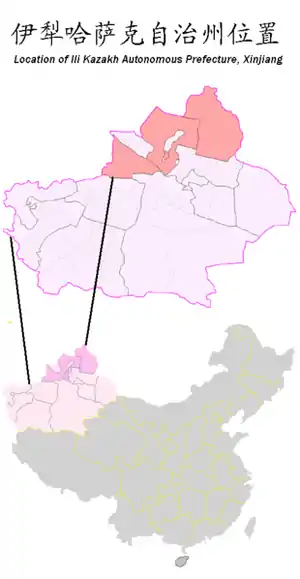Ghulja incident
The Ghulja incident (Chinese: 伊宁事件; pinyin: Yīníng Shìjiàn; also referred to as the Ghulja Massacre)[1] was the culmination of the Ghulja protests of 1997, a series of demonstrations[2] in the city of Ghulja (known as Yining (伊宁) in Chinese) in the Xinjiang autonomous region of China (PRC) beginning in early February 1997.
| Ghulja incident | |||
|---|---|---|---|
| Date | February 3, 1997 February 3-5, 1997 | ||
| Location | |||
| Caused by |
| ||
| Goals | Uyghur independence | ||
| Methods | Protests, rioting | ||
| Resulted in | Protests suppressed | ||
| Parties to the civil conflict | |||
| |||
| Casualties | |||
| Death(s) |
| ||
| Arrested | 1,600+ (dissident claims) | ||

Protests
The protests were sparked by the news of the execution of 30 Uyghur independence activists[3] as well as the crackdown on attempts to revive elements of traditional Uyghur culture, including traditional gatherings known as meshrep.[4] On 5 February 1997, after two days of protests during which the protesters had marched shouting "God is great" and "independence for Xinjiang"[5] and had reportedly been dispersed using clubs, water cannon, and tear gas,[6] the several demonstrators were killed by the Chinese Army gunfire.[6] Official reports put the death toll at 9,[7] while dissident reports estimated the number killed at more than 100[3] and even as many as 167.
Aftermath
According to dissident sources, as many as 1,600 people[3] were arrested on charges of intending to "split the motherland", conducting criminal activity, fundamental religious activity, and counter-revolutionary activities following the crackdown[8] carried out in the years immediately following the incident in Xinjiang, overwhelmingly against Uyghurs. Rebiya Kadeer, who witnessed the Ghulja Incident, went on to become leader of the World Uyghur Congress.
On February 5, 2014, the Uyghur American Association organized a demonstration in front of the Embassy of China in Washington, D.C. to commemorate the 17th anniversary of the Ghulja Massacre.[9]
Guantanamo
Some activists escaped to Afghanistan and then Pakistan under the Taliban. Then they were detained or sold to the USA forces who renditioned them to Guantanamo.[10]
See also
References
- "Protest marks Xinjiang 'massacre'". Al Jazeera. February 6, 2007.
- "Xinjiang to intensify crackdown on separatists", China Daily, 10/25/2001
- "Gulja Massacre". Channel 4 (UK). 1997.
- "China: Remember the Gulja massacre? China's crackdown on peaceful protesters". Amnesty International.
- "China's 'war on terror'". BBC News. September 10, 2002.
- "Uighur Developments in the 1990s". Global Security. 2008.
- "China Uighurs executed". BBC News. January 27, 1998.
- A report by Amnesty International documented as many as 190 execution "Gross Violations of Human Rights in the Xinjiang Uighur Autonomous Region". Amnesty International. 1999.
- "Uyghur American Association - Ghulja Massacre Protest". February 13, 2014. Retrieved May 7, 2020 – via YouTube.
- "The Guantanamo 22 | China | Al Jazeera". www.aljazeera.com. Retrieved January 3, 2019.